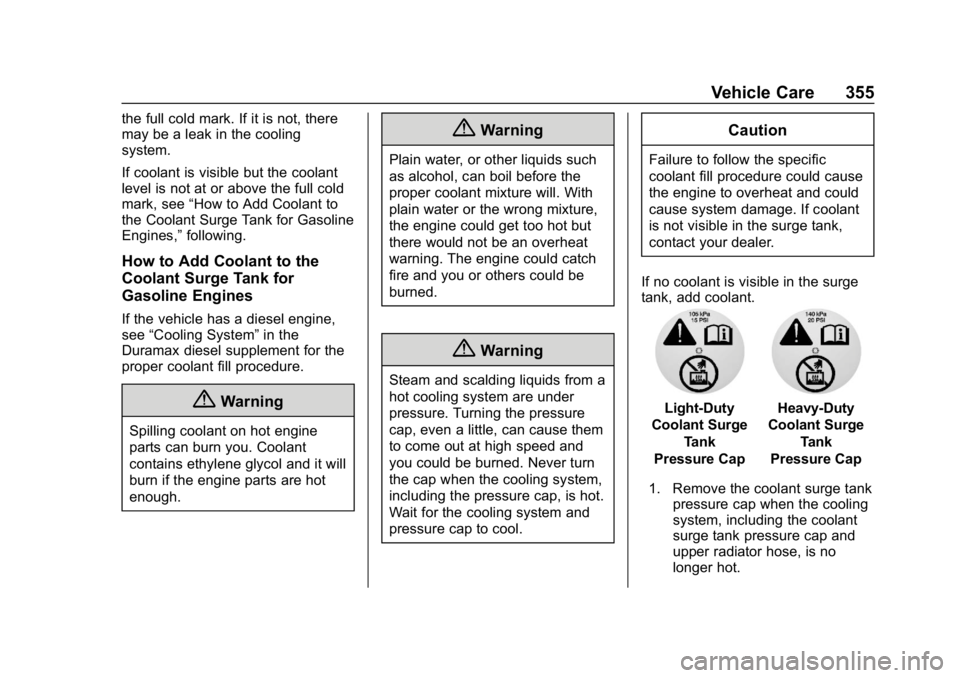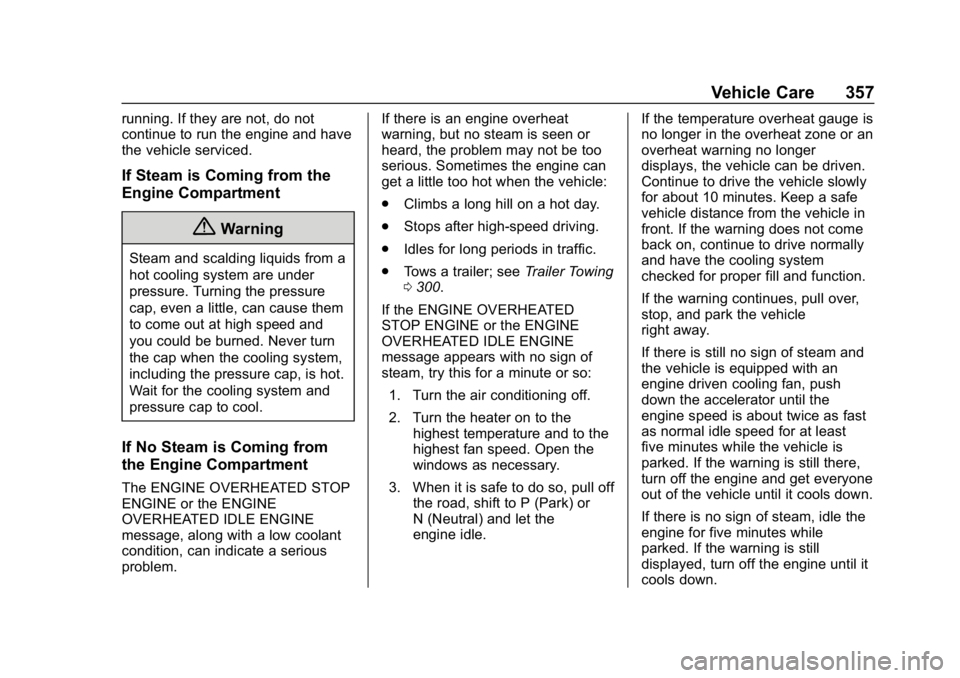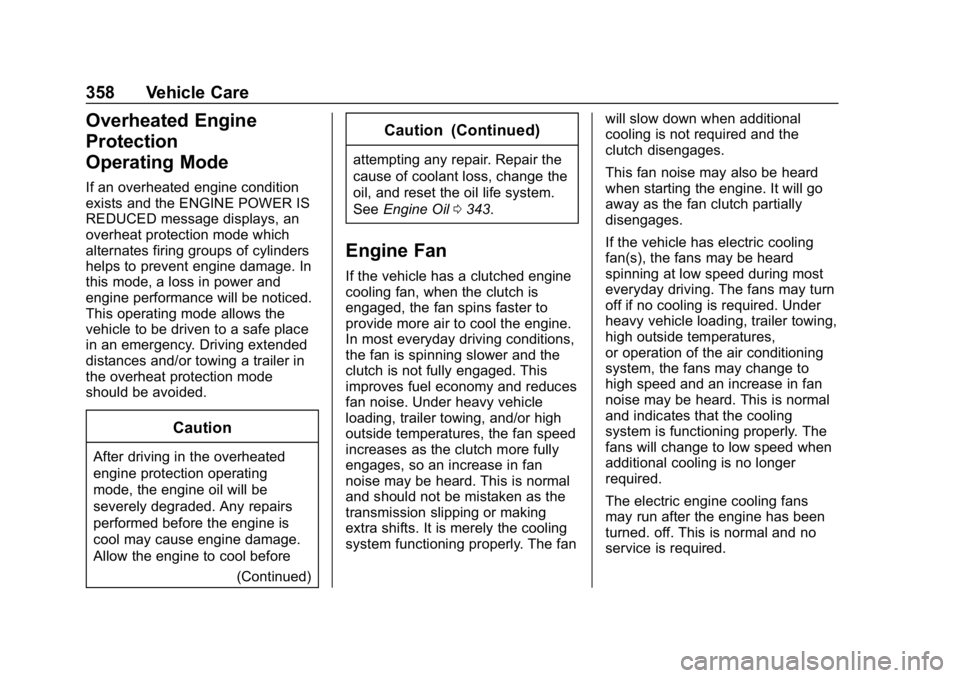2018 CHEVROLET SILVERADO engine overheat
[x] Cancel search: engine overheatPage 356 of 501

Chevrolet Silverado Owner Manual (GMNA-Localizing-U.S./Canada/Mexico-
11349200) - 2018 - CRC - 2/27/18
Vehicle Care 355
the full cold mark. If it is not, there
may be a leak in the cooling
system.
If coolant is visible but the coolant
level is not at or above the full cold
mark, see“How to Add Coolant to
the Coolant Surge Tank for Gasoline
Engines,” following.
How to Add Coolant to the
Coolant Surge Tank for
Gasoline Engines
If the vehicle has a diesel engine,
see“Cooling System” in the
Duramax diesel supplement for the
proper coolant fill procedure.
{Warning
Spilling coolant on hot engine
parts can burn you. Coolant
contains ethylene glycol and it will
burn if the engine parts are hot
enough.
{Warning
Plain water, or other liquids such
as alcohol, can boil before the
proper coolant mixture will. With
plain water or the wrong mixture,
the engine could get too hot but
there would not be an overheat
warning. The engine could catch
fire and you or others could be
burned.
{Warning
Steam and scalding liquids from a
hot cooling system are under
pressure. Turning the pressure
cap, even a little, can cause them
to come out at high speed and
you could be burned. Never turn
the cap when the cooling system,
including the pressure cap, is hot.
Wait for the cooling system and
pressure cap to cool.
Caution
Failure to follow the specific
coolant fill procedure could cause
the engine to overheat and could
cause system damage. If coolant
is not visible in the surge tank,
contact your dealer.
If no coolant is visible in the surge
tank, add coolant.
Light-Duty
Coolant Surge
Tank
Pressure CapHeavy-Duty
Coolant Surge
Tank
Pressure Cap
1. Remove the coolant surge tank pressure cap when the cooling
system, including the coolant
surge tank pressure cap and
upper radiator hose, is no
longer hot.
Page 357 of 501

Chevrolet Silverado Owner Manual (GMNA-Localizing-U.S./Canada/Mexico-
11349200) - 2018 - CRC - 2/27/18
356 Vehicle Care
Turn the pressure cap slowly
counterclockwise about one full
turn. If a hiss is heard, wait for
that to stop. A hiss means
there is still some pressure left.
2. Keep turning the pressure cap slowly, and remove it.
3. Fill the coolant surge tank with the proper mixture to the full
cold mark.
4. With the coolant surge tank pressure cap off, start the
engine and let it run until the
engine coolant temperature
gauge indicates approximately
90 °C (195 °F).
By this time, the coolant level
inside the coolant surge tank
may be lower. If the level is
lower, add more of the proper
mixture to the coolant surge
tank until the level reaches the
full cold mark.
5. Replace the pressure cap tightly. 6. Verify coolant level after the
engine is shut off and the
coolant is cold. If necessary,
repeat coolant fill procedure
Steps 1–6.
Caution
If the pressure cap is not tightly
installed, coolant loss and engine
damage may occur. Be sure the
cap is properly and tightly
secured.
Engine Overheating
If the vehicle has the Duramax
diesel engine, see the Duramax
diesel supplement.
Caution
Do not run the engine if there is a
leak in the engine cooling system.
This can cause a loss of all
coolant and can damage the
system and vehicle. Have any
leaks fixed right away. The vehicle has several indicators
to warn of engine overheating.
There is a coolant temperature
gauge in the vehicle's instrument
cluster. See
Engine Coolant
Temperature Gauge 0142.
In addition, there are ENGINE
OVERHEATED STOP ENGINE,
ENGINE OVERHEATED IDLE
ENGINE, and ENGINE POWER IS
REDUCED messages in the Driver
Information Center (DIC).
If the decision is made not to lift the
hood when this warning appears,
get service help right away. See
Roadside Assistance Program
0 465.
If the decision is made to lift the
hood, make sure the vehicle is
parked on a level surface.
4.3L V6, 5.3L V8, and 6.2L
V8 Engines
Check to see if the engine cooling
fans are running. If the engine is
overheating, the fans should be
Page 358 of 501

Chevrolet Silverado Owner Manual (GMNA-Localizing-U.S./Canada/Mexico-
11349200) - 2018 - CRC - 2/27/18
Vehicle Care 357
running. If they are not, do not
continue to run the engine and have
the vehicle serviced.
If Steam is Coming from the
Engine Compartment
{Warning
Steam and scalding liquids from a
hot cooling system are under
pressure. Turning the pressure
cap, even a little, can cause them
to come out at high speed and
you could be burned. Never turn
the cap when the cooling system,
including the pressure cap, is hot.
Wait for the cooling system and
pressure cap to cool.
If No Steam is Coming from
the Engine Compartment
The ENGINE OVERHEATED STOP
ENGINE or the ENGINE
OVERHEATED IDLE ENGINE
message, along with a low coolant
condition, can indicate a serious
problem.If there is an engine overheat
warning, but no steam is seen or
heard, the problem may not be too
serious. Sometimes the engine can
get a little too hot when the vehicle:
.
Climbs a long hill on a hot day.
. Stops after high-speed driving.
. Idles for long periods in traffic.
. Tows a trailer; see Trailer Towing
0 300.
If the ENGINE OVERHEATED
STOP ENGINE or the ENGINE
OVERHEATED IDLE ENGINE
message appears with no sign of
steam, try this for a minute or so: 1. Turn the air conditioning off.
2. Turn the heater on to the highest temperature and to the
highest fan speed. Open the
windows as necessary.
3. When it is safe to do so, pull off the road, shift to P (Park) or
N (Neutral) and let the
engine idle. If the temperature overheat gauge is
no longer in the overheat zone or an
overheat warning no longer
displays, the vehicle can be driven.
Continue to drive the vehicle slowly
for about 10 minutes. Keep a safe
vehicle distance from the vehicle in
front. If the warning does not come
back on, continue to drive normally
and have the cooling system
checked for proper fill and function.
If the warning continues, pull over,
stop, and park the vehicle
right away.
If there is still no sign of steam and
the vehicle is equipped with an
engine driven cooling fan, push
down the accelerator until the
engine speed is about twice as fast
as normal idle speed for at least
five minutes while the vehicle is
parked. If the warning is still there,
turn off the engine and get everyone
out of the vehicle until it cools down.
If there is no sign of steam, idle the
engine for five minutes while
parked. If the warning is still
displayed, turn off the engine until it
cools down.
Page 359 of 501

Chevrolet Silverado Owner Manual (GMNA-Localizing-U.S./Canada/Mexico-
11349200) - 2018 - CRC - 2/27/18
358 Vehicle Care
Overheated Engine
Protection
Operating Mode
If an overheated engine condition
exists and the ENGINE POWER IS
REDUCED message displays, an
overheat protection mode which
alternates firing groups of cylinders
helps to prevent engine damage. In
this mode, a loss in power and
engine performance will be noticed.
This operating mode allows the
vehicle to be driven to a safe place
in an emergency. Driving extended
distances and/or towing a trailer in
the overheat protection mode
should be avoided.
Caution
After driving in the overheated
engine protection operating
mode, the engine oil will be
severely degraded. Any repairs
performed before the engine is
cool may cause engine damage.
Allow the engine to cool before(Continued)
Caution (Continued)
attempting any repair. Repair the
cause of coolant loss, change the
oil, and reset the oil life system.
SeeEngine Oil 0343.
Engine Fan
If the vehicle has a clutched engine
cooling fan, when the clutch is
engaged, the fan spins faster to
provide more air to cool the engine.
In most everyday driving conditions,
the fan is spinning slower and the
clutch is not fully engaged. This
improves fuel economy and reduces
fan noise. Under heavy vehicle
loading, trailer towing, and/or high
outside temperatures, the fan speed
increases as the clutch more fully
engages, so an increase in fan
noise may be heard. This is normal
and should not be mistaken as the
transmission slipping or making
extra shifts. It is merely the cooling
system functioning properly. The fan will slow down when additional
cooling is not required and the
clutch disengages.
This fan noise may also be heard
when starting the engine. It will go
away as the fan clutch partially
disengages.
If the vehicle has electric cooling
fan(s), the fans may be heard
spinning at low speed during most
everyday driving. The fans may turn
off if no cooling is required. Under
heavy vehicle loading, trailer towing,
high outside temperatures,
or operation of the air conditioning
system, the fans may change to
high speed and an increase in fan
noise may be heard. This is normal
and indicates that the cooling
system is functioning properly. The
fans will change to low speed when
additional cooling is no longer
required.
The electric engine cooling fans
may run after the engine has been
turned. off. This is normal and no
service is required.
Page 377 of 501

Chevrolet Silverado Owner Manual (GMNA-Localizing-U.S./Canada/Mexico-
11349200) - 2018 - CRC - 2/27/18
376 Vehicle Care
Headlamp Wiring
An electrical overload may cause
the lamps to go on and off, or in
some cases to remain off. Have the
headlamp wiring checked right away
if the lamps go on and off or
remain off.
Windshield Wipers
If the wiper motor overheats due to
heavy snow or ice, the windshield
wipers will stop until the motor cools
and will then restart.
Although the circuit is protected
from electrical overload, overload
due to heavy snow or ice may
cause wiper linkage damage.
Always clear ice and heavy snow
from the windshield before using the
windshield wipers.
If the overload is caused by an
electrical problem and not snow or
ice, be sure to get it fixed.
Fuses and Circuit
Breakers
The wiring circuits in the vehicle are
protected from short circuits by a
combination of fuses and circuit
breakers. This greatly reduces the
chance of damage caused by
electrical problems.
{Danger
Fuses and circuit breakers are
marked with their ampere rating.
Do not exceed the
specified amperage rating when
replacing fuses and circuit
breakers. Use of an oversized
fuse or circuit breaker can result
in a vehicle fire. You and others
could be seriously injured or
killed.
To check a fuse, look at the
silver-colored band inside the fuse.
If the band is broken or melted,
replace the fuse. Be sure to replace
a bad fuse with a new one of the
identical size and rating. Fuses of the same amperage can
be temporarily borrowed from
another fuse location, if a fuse goes
out. Replace the fuse as soon as
possible.
Engine Compartment
Fuse Block
If the vehicle has a diesel engine,
see the Duramax diesel
supplement.
The engine compartment fuse block
is in the engine compartment, on
the driver side of the vehicle.
Page 491 of 501

Chevrolet Silverado Owner Manual (GMNA-Localizing-U.S./Canada/Mexico-
11349200) - 2018 - CRC - 2/27/18
490 Index
D
Damage Repair, Collision . . . . . . . 468
Danger, Warning, and Caution . . . . 3
Data CollectionInfotainment System . . . . . . . . . . 474
OnStar . . . . . . . . . . . . . . . . . . . . . . . 474
Data Recorders, Event . . . . . . . . . 473
Daytime Running Lamps (DRL) . . . . . . . . . . . . . . . . . . 174
Defensive Driving . . . . . . . . . . . . . . . 228
Diagnostics
OnStar . . . . . . . . . . . . . . . . . . . . . . . 480
Distracted Driving . . . . . . . . . . . . . . . 227
Dome Lamps . . . . . . . . . . . . . . . . . . . 178
Door Locks . . . . . . . . . . . . . . . . . . . . . . . . . . . 40
Power Locks . . . . . . . . . . . . . . . . . . . . 41
Drive Belt Routing, Engine . . . . . . 460
Driver Assistance Systems . . . . . 281
Driver Information Center (DIC) . . . . . . . . . . . . . 155, 156
Driving Assistance Systems . . . . . . . . . . 285
Characteristics andTowing Tips . . . . . . . . . . . . . . . . . 296
Defensive . . . . . . . . . . . . . . . . . . . . . 228
Drunk . . . . . . . . . . . . . . . . . . . . . . . . . 228
For Better Fuel Economy . . . . . . . 32 Driving (cont'd)
Hill and Mountain Roads . . . . . . 236
If the Vehicle is Stuck . . . . . . . . . 238
Loss of Control . . . . . . . . . . . . . . . 230
Off-Road . . . . . . . . . . . . . . . . . . . . . 231
Off-Road Recovery . . . . . . . . . . . 230
Vehicle Load Limits . . . . . . . . . . . 239
Wet Roads . . . . . . . . . . . . . . . . . . . 235
Winter . . . . . . . . . . . . . . . . . . . . . . . . 237
Dual Automatic Climate Control System . . . . . . . . . . . . . . . . 220
E
E85 or FlexFuel . . . . . . . . . . . . . . . . 293
Electrical Equipment,Add-On . . . . . . . . . . . . . . . . . . . . . . . 329
Electrical System Engine Compartment FuseBlock . . . . . . . . . . . . . . . . . . . . . . . . 376
Fuses and Circuit Breakers . . . 376
Instrument Panel Fuse Block . . . . . . . . . . . . . . . . . . . 380, 381
Overload . . . . . . . . . . . . . . . . . . . . . 375
Emergency
OnStar . . . . . . . . . . . . . . . . . . . . . . . 476
Engine Air Cleaner/Filter . . . . . . . . . . . . . 351 Engine (cont'd)
Check Light (Malfunction
Indicator) . . . . . . . . . . . . . . . . . . . . 147
Compartment Overview . . . . . . . 338
Coolant Heater . . . . . . . . . . . . . . . 252
Coolant Temperature
Gauge . . . . . . . . . . . . . . . . . . . . . . 142
Cooling System . . . . . . . . . . . . . . . 352
Drive Belt Routing . . . . . . . . . . . . 460
Exhaust . . . . . . . . . . . . . . . . . . . . . . 256
Fan . . . . . . . . . . . . . . . . . . . . . . . . . . . 358
Oil Life System . . . . . . . . . . . . . . . 346
Oil Pressure Gauge . . . . . . . . . . 141
Overheated Protection Operating Mode . . . . . . . . . . . . . 358
Overheating . . . . . . . . . . . . . . . . . . 356
Power Messages . . . . . . . . . . . . . 160
Running While Parked . . . . . . . . 257
Starting . . . . . . . . . . . . . . . . . . . . . . . 249
Entry Lighting . . . . . . . . . . . . . . . . . . . 179
Equipment, Towing . . . . . . . . . . . . . 318
Event Data Recorders . . . . . . . . . . 473
Exit Lighting . . . . . . . . . . . . . . . . . . . . 179
Extender, Seat Belt . . . . . . . . . . . . . . 75
Exterior Lamp Controls . . . . . . . . . 171
Exterior Lamps Off Reminder . . . 173
Exterior Lighting Battery Saver . . . . . . . . . . . . . . . . . . . . . . . . . 180
Page 495 of 501

Chevrolet Silverado Owner Manual (GMNA-Localizing-U.S./Canada/Mexico-
11349200) - 2018 - CRC - 2/27/18
494 Index
Manual Transmission . . . . . . . . . . . 263Fluid . . . . . . . . . . . . . . . . . . . . . . . . . . 350
Manual Windows . . . . . . . . . . . . . . . . 52
Media Avoiding Untrusted Devices . . 190
Memory Features . . . . . . . . . . . . . . . . 13
Memory Seats . . . . . . . . . . . . . . . . . . . 62
Messages Engine Power . . . . . . . . . . . . . . . . 160
Vehicle . . . . . . . . . . . . . . . . . . . . . . . 159
Vehicle Speed . . . . . . . . . . . . . . . . 160
Mirrors Automatic Dimming . . . . . . . . . . . . . 50
Automatic DimmingRearview . . . . . . . . . . . . . . . . . . . . . . 52
Blind Spot . . . . . . . . . . . . . . . . . . . . . . 50
Convex . . . . . . . . . . . . . . . . . . . . . . . . . 47
Folding . . . . . . . . . . . . . . . . . . . . . . . . . 49
Heated . . . . . . . . . . . . . . . . . . . . . . . . . 50
Manual . . . . . . . . . . . . . . . . . . . . . . . . . 47
Manual Rearview . . . . . . . . . . . . . . . 52
Power . . . . . . . . . . . . . . . . . . . . . . . . . . 48
Tilt in Reverse . . . . . . . . . . . . . . . . . . 51
Trailer Tow . . . . . . . . . . . . . . . . . . . . . . 48
Mirrors, Interior Rearview . . . . . . . . 51
Monitor System, Tire
Pressure . . . . . . . . . . . . . . . . . . . . . . 394
Multi-band Antenna . . . . . . . . . . . . . 189N
Navigation OnStar . . . . . . . . . . . . . . . . . . . . . . . 477
New Vehicle Break-In . . . . . . . . . . . 247
Noise Control System . . . . . . . . . . 366
O
Odometer . . . . . . . . . . . . . . . . . . . . . . . 140 Trip . . . . . . . . . . . . . . . . . . . . . . . . . . . 140
Off-Road . . . . . . . . . . . . . . . . . . . . . . . 231 Driving . . . . . . . . . . . . . . . . . . . . . . . . 231
Recovery . . . . . . . . . . . . . . . . . . . . . 230
Oil Engine . . . . . . . . . . . . . . . . . . . . . . . . 343
Engine Oil Life System . . . . . . . 346
Engine Oil Pressure Gauge . . . 141
Older Children, Restraints . . . . . . . 92
Online Owner Center . . . . . . . . . . . 464
OnStar . . . . . . . . . . . . . . . . . . . . . . . . . 474
OnStar Additional Information . . . . . . . . . . . . . . . . . . . . 481
OnStar Connections . . . . . . . . . . . . 478
OnStar Diagnostics . . . . . . . . . . . . . 480
OnStar Emergency . . . . . . . . . . . . . 476
OnStar Navigation . . . . . . . . . . . . . . 477
OnStar Overview . . . . . . . . . . . . . . . 475
OnStar Security . . . . . . . . . . . . . . . . 477 Operating Mode
Overheated Engine
Protection . . . . . . . . . . . . . . . . . . . 358
Operation Fog Lamps . . . . . . . . . . . . . . . . . . . 176
Ordering Service Publications . . . . . . . . . . 470
Outlets Power . . . . . . . . . . . . . . . . . . . . . . . . 132
Overheated Engine Protection Operating Mode . . . . 358
Overheating, Engine . . . . . . . . . . . . 356
Overview . . . . . . . . . . . . . . . . . . . . . . . 183
P
Park Shifting Into . . . . . . . . . . . . . . . . . . . 253
Shifting Out of . . . . . . . . . . . . . . . . 255
Parking . . . . . . . . . . . . . . . . . . . . . . . . . 255 Brake . . . . . . . . . . . . . . . . . . . . . . . . . 273
Brake and P (Park)Mechanism Check . . . . . . . . . . 368
Over Things That Burn . . . . . . . 255
Parking Assist . . . . . . . . . . . . . . . . . . 282
Parking or Backing Assistance Systems . . . . . . . . . . 282
Passenger Airbag Status Indicator . . . . . . . . . . . . . . . . . . . . . . 146